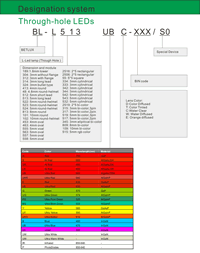Through hole LED
Series No:
Weight:(g/pcs)
Dimension:(mm)
Package:
Specification:
Inquiry
Description:
Introduction
In the ever-evolving landscape of electronic components, oval LEDs have carved a niche for themselves, especially the 4mm variants. Known for their unique shape and significant efficiency, these LEDs offer a plethora of advantages over their counterparts. From illuminating consumer electronics to indicating statuses in industrial machines, the applications of 4mm oval LED diodes are vast and varied. This article aims to shed light on their features, applications, and benefits, supplemented by real-world case studies and user testimonials to illustrate their impact in the electronics industry.
Features of 4mm Oval LED Diodes
Oval LEDs, particularly the 4mm type, are designed to provide focused lighting with a wider viewing angle, making them ideal for applications where directional light is crucial. Their thru-hole design facilitates easy mounting on PCBs with LEDs, ensuring that they can be integrated into various electronic devices effortlessly. These diodes are renowned for their durability, long lifespan, and low power consumption, which make them an eco-friendly and cost-effective lighting solution.
Applications in Electronics
The applications of 4mm oval LED diodes are diverse. They are extensively used in:
- Consumer electronics for display and backlighting purposes.
- Automotive lighting, particularly for dashboards and indicator lights.
- Outdoor signage and advertising, where visibility from different angles is required.
- Industrial machinery as status indicators and illuminators.
The thru-hole technology of these LEDs makes them versatile for use in both prototype projects and mass-produced electronic devices.
The Benefits Unveiled
The adoption of 4mm oval LEDs comes with a multitude of benefits:
- Energy Efficiency: They consume significantly less power compared to traditional lighting solutions.
- Longevity: These LEDs have a prolonged operational life, reducing the need for frequent replacements.
- Design Flexibility: The unique shape and compact size allow for innovative design applications.
- Environmental Impact: Their low energy consumption and long lifespan contribute to a reduction in environmental footprint.
Case Studies: Lighting the Way
This section would delve into specific case studies where 4mm oval LED diodes have been instrumental in solving lighting challenges, highlighting the practical benefits and innovative applications in various industries.
User Testimonials: In Their Own Words
Hearing directly from engineers, purchasers, and administrators who have implemented 4mm oval LEDs in their projects can provide invaluable insights into their practical applications and benefits.
Conclusion: A Bright Future Ahead
The future looks bright for 4mm oval LED diodes as they continue to illuminate the path towards innovative, efficient, and eco-friendly lighting solutions. Their unique features, coupled with their versatility in applications, make them a preferred choice for electronics manufacturers globally. As technology advances, the potential applications of these LEDs are bound to expand, further solidifying their position in the electronics industry.
Call to Action: Embrace the future of lighting by incorporating 4mm oval LED diodes into your next project. Discover the difference in efficiency, design, and sustainability.
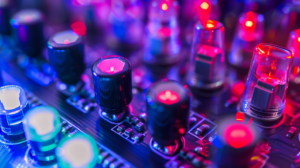
Features
- 4mm Oval Type (3.7 x 3.95 x 6.5mm) LED Lamps: The oval shape of these LEDs offers a distinct aesthetic and can provide a different light distribution compared to standard round LEDs.
- Various Viewing Angles: Available in a range of viewing angles, allowing for customization based on specific application needs and ensuring optimal visibility.
- Lens Options: These LEDs are offered with diffused, transparent, and water-clear lenses. Diffused lenses create a softer light spread, transparent lenses offer a crisper light output, and water-clear lenses provide a more focused and intense light.
- IC Compatibility / Low Current Capability: Can be easily integrated with integrated circuits, suitable for complex electronic designs. The low current operation of these LEDs enhances energy efficiency, making them ideal for both battery-powered and energy-saving applications.
- RoHS Compliance: Adheres to the Restriction of Hazardous Substances Directive, ensuring they are environmentally friendly and safe for use in various applications.
Applications
- Indicator Lights: Commonly used in electronic devices, appliances, and control panels as indicators for power, operational states, or alerts.
- Automotive Lighting: Suitable for both interior and exterior lighting in vehicles, including dashboard lighting, signal lights, and decorative applications.
- Consumer Electronics: Utilized in consumer electronics for display or decorative purposes, such as in remote controls, audio equipment, and portable devices.
- Signal and Signage Applications: Employed in digital billboards, traffic signals, and signage for their high visibility and durability.
- Toys and Novelty Items: Integrated into toys and novelty items to add visual appeal and functionality.
- Decorative Lighting: Used in decorative lighting solutions for homes, commercial spaces, and events, offering a unique aesthetic due to their oval shape.
- DIY Projects and Hobby Electronics: Popular in DIY electronics and hobbyist projects for their unique shape and versatility.
- Safety and Emergency Equipment: Ideal for use in safety signs and emergency lighting, where their distinct shape can be beneficial for specific design requirements.


Electrical-optical characteristics:
Article No | color | material | wavelength | apperance | v_typ | v_max | luminous_min | luminous_typ | degree |
|---|---|---|---|---|---|---|---|---|---|
BL-L463BC |
Blue |
InGaN |
430 |
Water Clear |
4.2 |
250 |
800 |
X-X:4 |
|
BL-L463BGC |
Ultra Bluish Green |
InGaN |
505 |
Water Clear |
4.2 |
600 |
1500 |
X-X:4 |
|
BL-L463LRC |
Super Red |
AlGaAs,DH |
660 |
Water Clear |
2.2 |
150 |
300 |
X-X:4 |
|
BL-L463PGC |
Ultra Pure Green |
InGaN |
525 |
Water Clear |
4.2 |
800 |
1800 |
X-X:4 |
|
BL-L463SRC |
Hi Red |
AlGaAs,SH |
660 |
Water Clear |
2.2 |
50 |
150 |
X-X:4 |
|
BL-L463UBC |
Ultra Blue |
InGaN |
470 |
Water Clear |
4.2 |
600 |
1500 |
X-X:4 |
|
BL-L463UEC |
Ultra Orange |
AlGaInP |
630 |
Water Clear |
2.5 |
300 |
800 |
X-X:4 |
|
BL-L463UGC |
Ultra Green |
AlGaInP |
574 |
Water Clear |
2.5 |
100 |
250 |
X-X:4 |
|
BL-L463URC |
Ultra Red |
AlGaAs,DDH |
660 |
Water Clear |
2.2 |
300 |
850 |
X-X:4 |
|
BL-L463UWC |
Ultra White |
InGaN |
- |
Water Clear |
4.2 |
1000 |
2300 |
X-X:4 |
|
BL-L463UYC |
Ultra Yellow |
AlGaInP |
590 |
Water Clear |
2.5 |
300 |
800 |
X-X:4 |
|
BL-L463VC |
UV |
InGaN |
405 |
Water Clear |
4.2 |
40 |
80 |
X-X:4 |
Package configuration & Internal circuit diagram
Partno description:
More Information
Lens Color:
| Code | D | T | C | W | E | |
| Meaning | color Diffused | Color Tinted | Water Clear | Water Diffused | Orange diffused |
Absolute maximum ratings (Ta=25°C)
| Parameter | SR | LR | UR | UE | UY | UG | PG | BG | B | UB | UV | W | Unit |
| Forward Current I F | 25 | 25 | 25 | 30 | 30 | 30 | 30 | 30 | 30 | 30 | 30 | 30 | mA |
| Power Dissipation P d | 60 | 60 | 60 | 65 | 65 | 75 | 110 | 110 | 120 | 120 | 120 | 120 | mW |
| Reverse Voltage V R | 5 | 5 | 5 | 5 | 5 | 5 | 5 | 5 | 5 | 5 | 5 | 5 | V |
| Peak Forward Current I PF (Duty 1/10 @1KHZ) | 150 | 150 | 150 | 150 | 150 | 150 | 150 | 100 | 100 | 100 | 100 | 100 | mA |
| Operation Temperature T OPR | -40 to +80 | °C | |||||||||||
| Storage Temperature T STG | -40 to +85 | °C | |||||||||||
| Lead Soldering Temperature T SOL | Max.260+-5°C for 3 sec Max. (1.6mm from the base of the epoxy bulb) | °C | |||||||||||
Related Information
Applied for: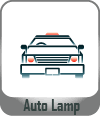

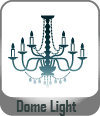
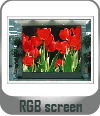
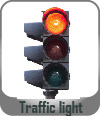
The LEDs described here are intended to be used for ordinary electronic equipment (such as office equipment,
communication equipment and household applications). Consult Betlux’s Sales in advance for information on
applications in which exceptional reliability is required, particularly when the failure or malfunction of the LEDs
may directly jeopardize life or health (such as in aviation, transportation, traffic control equipment, medical
and life support systems and safety devices).
CAUTIONS for Through-Hole LED Lamps
1. Application
The LEDs described here are intended to be used for ordinary electronic equipment (such as office equipment, communication equipment and household applications). Consult Betlux’s Sales in advance for information on applications in which exceptional reliability is required, particularly when the failure or malfunction of the LEDs may directly jeopardize life or health (such as in aviation, transportation, traffic control equipment, medical and life support systems and safety devices).
2. Storage
The storage ambient for the LEDs should not exceed 30℃ temperature or 70% relative humidity. It is
recommended that LEDs out of their original packaging are used within three months
For extended storage out of their original packaging, it is recommended that the LEDs be stored in a sealed
container with appropriate desiccant or in a desiccator with nitrogen ambient.
3. Cleaning
Use alcohol-based cleaning solvents such as isopropyl alcohol to clean the LED if necessary
4. Lead Forming & Assembly
During lead forming, the leads should be bent at a point at least 3mm from the base of LED lens. Do not use
the base of the leadframe as a fulcrum during forming.
Lead forming must be done before soldering, at normal temperature.
During assembly on PCB, use minimum clinch force possible to avoid excessive mechanical stress.
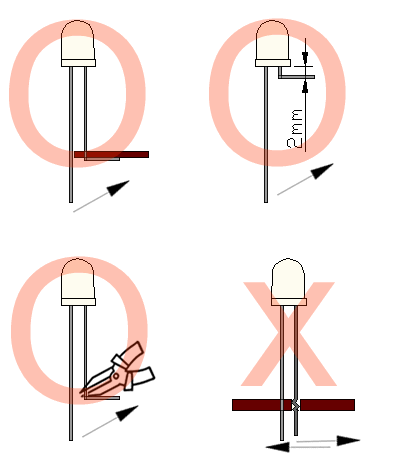
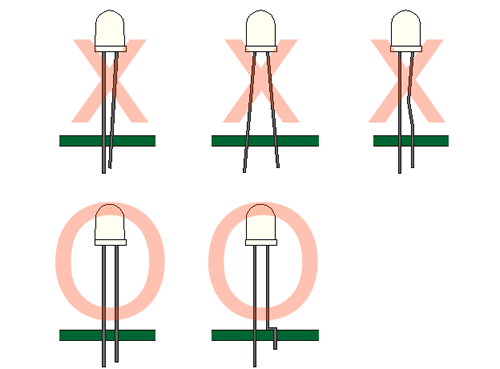
Soldering
When soldering, leave a minimum of 2mm clearance from the base of the base of the lens to the soldering point. Dipping the lens into the solder must be avoided.
Do not apply any external stress to the lead frame during soldering while the LED is at high temperature.
Recommended soldering conditions:
| IR Reflow Soldering (for SMD display) | Wave Soldering | Soldering Iron | |||
| Pre-Heat | 150-180°C | Pre-Heat | 100°C Max. | Temperature | 300°C Max. |
| Pre-Heat Time | 120sec Max. | Pre-Heat Time | 60sec Max. | ||
| Peak Temperature | 260°C Max. | SolderWave | 260°C Max. | Soldering Time | 3sec Max.(one time only) |
| Soldering Time | 10 sec Max. | Soldering Time | 5sec Max. | ||
Note: Excessive soldering temperature and/or time might result in deformation of the LED lens or failure of the LED
ESD(Electrostatic Discharge)
Static Electricity or power surge will damage the LED.
Suggestions to prevent ESD (Electrostatic Discharge):
n Use a conductive wrist band or anti-electrostatic glove when handling these LEDs
n All devices, equipment, and machinery must be properly grounded
n Work tables, storage racks, etc. should be properly grounded
n Use ion blower to neutralize the static charge which might have built up on surface of the LED’s
plastic lens as a result of friction between LEDs during storage and handling
ESD-damaged LEDs will exhibit abnormal characteristics such as high reverse leakage current,
low forward voltage, or “no light on” at low currents. To verify for ESD damage, check for “light on”
and Vf of the suspect LEDs at low currents.
The Vf of “good” LEDs should be>2.0V@0.1mA for InGaN product and >1.4V@0.1mA for AlInGaP
product.

Drive Method
An LED is a current-operated device. In order to ensure intensity uniformity on multiple LEDs connected in
parallel in an application, it is recommended that a current limiting resistor be incorporated in the drive circuit,
in series with each LED as shown in Circuit A below.
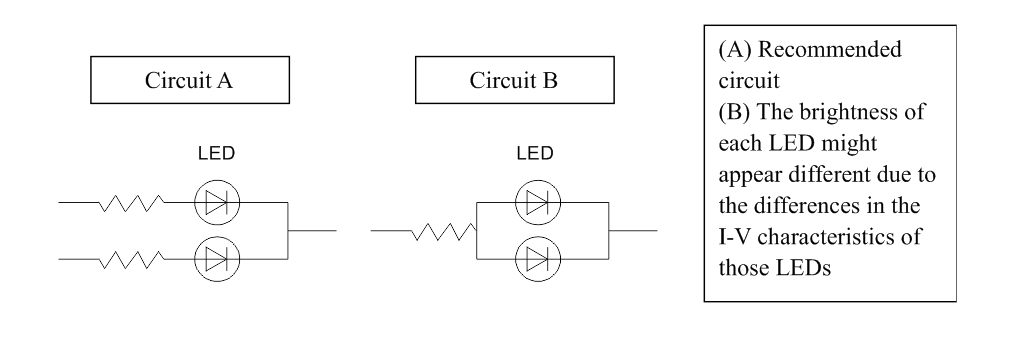
When selecting power for LED systems, it’s essential to understand several key parameters to ensure safe operation, longevity, and optimal performance. Here are some steps and considerations for LED power selection:
- Determine the Forward Voltage (Vf) of the LED(s):
Each LED has a forward voltage, which is the voltage at which the LED operates when the current is flowing through it. This value can typically be found in the LED’s datasheet.
- Determine the Forward Current (If) of the LED(s):
The forward current is the current at which the LED is designed to operate. Running an LED at higher than its rated current can reduce its lifespan and increase the heat it produces.
- Decide on the Configuration:
Series Configuration: When LEDs are connected in series, the forward voltages add up, but the current remains the same.
Parallel Configuration: When LEDs are connected in parallel, the forward voltage remains the same, but the currents add up. This configuration can be risky because if one LED fails or has a slightly lower forward voltage, it can cause the other LEDs to draw more current.
Calculate Total Power Requirements:
Power (W) = Total Forward Voltage (V) x Total Forward Current (A)
For example, if you have three LEDs connected in series, each with a forward voltage of 3V and a forward current of 20mA, the total power requirement would be:
Power = (3V + 3V + 3V) x 20mA = 9V x 0.02A = 0.18W
- Select an Appropriate Power Supply:
- Voltage Rating: The power supply voltage should match or slightly exceed the total forward voltage of your LED configuration.
- Current Rating: The power supply’s current rating should meet or exceed the total forward current of your LED configuration.
- Safety Margin: It’s a good practice to select a power supply that can provide at least 20% more power than your calculated requirement. This ensures the power supply isn’t operating at its maximum capacity, which can extend its life and ensure safer operation.
- Consider Additional Features:
- Dimming Capability: If you want to control the brightness of your LEDs, choose a power supply with dimming capabilities.
- Overcurrent and Overvoltage Protection: To protect your LEDs, select a power supply with built-in protection mechanisms.
- Thermal Management: Ensure that the power supply has adequate cooling, especially if it will be enclosed or in a location with limited airflow.
- Regulation and Efficiency:A power supply with good regulation will maintain a consistent voltage output despite variations in the load. High efficiency ensures minimal power is wasted as heat.
- Physical Size and Form Factor:Depending on where you plan to place the power supply, its size and shape may be critical factors.
In summary, when selecting power for LED systems, understanding your LED’s requirements and the configuration you plan to use is essential. Then, pick a power supply that meets those needs with some added safety margin, keeping in mind any additional features or constraints relevant to your project.
Here are some well-regarded brands in the industry:
- Mean Well: One of the most recognized brands in the LED power supply industry, Mean Well offers a wide range of products suitable for both indoor and outdoor applications. Their units often come with features like overcurrent protection, dimming capabilities, and high efficiency.
- Tridonic: A global leader in lighting technology, Tridonic offers LED drivers and power supplies that cater to various lighting solutions, from simple setups to advanced smart lighting systems.
- Philips Advance Xitanium: Philips is a well-known brand in the lighting industry, and their Xitanium series of LED drivers are known for reliability and performance. They cater to both indoor and outdoor LED applications.
- Osram: Another giant in the lighting industry, Osram offers a range of LED drivers and power supplies suitable for various applications, including architectural and street lighting.
- LIFUD: Specializing in LED drivers, LIFUD is known for its high-quality products that cater to both commercial and residential LED lighting solutions.
- MOSO: This brand offers a variety of LED drivers, especially for outdoor and industrial applications. Their products are known for durability and performance.
- TDK-Lambda: With a history in power electronics, TDK-Lambda offers a range of power supplies and LED drivers suitable for various applications, emphasizing reliability and advanced features.


-led-lamp.gif)
